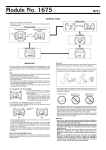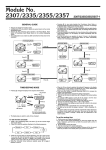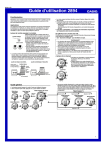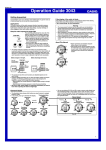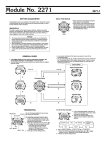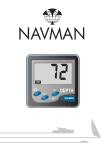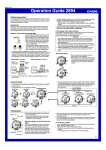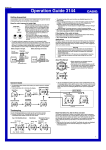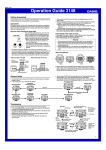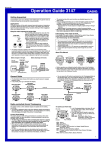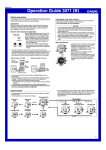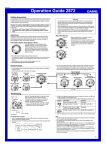Download Casio 3022 Watch User Manual
Transcript
MO0912-EB Operation Guide 3022 Getting Acquainted Congratulations upon your selection of this CASIO watch. To get the most out of your purchase, be sure to read this manual carefully. Applications The built-in sensors of this watch measure barometric pressure, temperature and altitude. Measured values are then shown on the display. Such features make this watch useful when hiking, mountain climbing, or when engaging in other such outdoor activities. Keep the watch exposed to bright light The electricity generated by the solar cell of the watch is stored by a built-in battery. Leaving or using the watch where it is not exposed to light causes the battery to run down. Make sure the watch is exposed to light as much as possible. • When you are not wearing the watch on your wrist, position the face so it is pointed at a source of bright light. • You should try to keep the watch outside of your sleeve as much as possible. Charging is reduced significantly if the face is covered only partially. l l l l l l l l l l l Bright light Solar cell • The watch continues to operate, even when it is not exposed to light. Leaving the watch in the dark can cause the battery to run down, which will cause some watch functions to be disabled. If the battery goes dead, you will have to re-configure watch settings after recharging. To ensure normal watch operation, be sure to keep it exposed to light as much as possible. Battery charges in the light. Solar cell (Converts light to electrical power.) • The actual level at which some functions are disabled depends on the watch model. • Frequent display illumination can run down the battery quickly and require charging. The following guidelines give an idea of the charging time required to recover from a single illumination operation. Approximately five minutes exposure to bright sunlight coming in through a window Approximately 50 minutes exposure to indoor fluorescent lighting • Be sure to read “Power Supply” for important information you need to know when exposing the watch to bright light. If the display of the watch is blank... If the display of the watch is blank, it means that the watch’s Power Saving function has turned off the display to conserve power. • See “Power Saving” for more information. Warning! • The measurement functions built into this watch are not intended for taking measurements that require professional or industrial precision. Values produced by this watch should be considered as reasonable representations only. • CASIO COMPUTER CO., LTD. assumes no responsibility for any loss, or any claims by third parties that may arise through the use of this watch. About This Manual • Button operations are indicated using the letters shown in the illustration. • Each section of this manual provides you with the information you need to perform operations in each mode. Further details and technical information can be found in the “Reference” (Light) section. Battery discharges in the dark. Bright light Electrical energy LEVEL 1 LEVEL 2 All functions enabled LEVEL 1 LEVEL 2 Dis- LEVEL 3 charge LEVEL 4 LEVEL 3 Charge LEVEL 4 Some functions disabled Rechargeable battery General Guide • The illustration below shows which buttons you need to press to navigate between modes. • In any mode, press L to illuminate the display. Sensor Modes Timekeeping Mode Press B. Press D. Barometer/ Thermometer Mode ▲ ▲ Press C. ▲ Data Recall Mode ▲ Stopwatch Mode • You can use buttons B and D to enter a sensor mode directly from the Timekeeping Mode or from another sensor mode. To enter a sensor mode from the Data Recall, Stopwatch, Countdown Timer, or Alarm Mode, first enter the Timekeeping Mode and then press the applicable button. Altimeter Mode ▲ Alarm Mode ▲ ▲ Countdown Timer Mode ▲ Press C. Timekeeping Use the Timekeeping Mode to set and view the current time and date. • In the Timekeeping Mode, each press of A toggles the display between the timekeeping screen and the barometric pressure graph screen. Timekeeping Screen Barometric Pressure Graph Screen Barometric pressure graph Month – Day ▲ ▲ PM indicator Seconds Hour : Minutes 1. In the Timekeeping Mode, hold down A until the seconds start to flash, which indicates the setting screen. 2. Press C to move the flashing in the sequence shown below to select the other settings. Seconds Barometric Pressure Unit Press A. Day of week To set the time and date Hour Minutes Altitude Unit 12/24-Hour Format Temperature Unit Year Power Saving Month Day • The following steps explain how to configure timekeeping settings only. Hour : Minutes 1 Operation Guide 3022 3. When the timekeeping setting you want to change is flashing, use B and/ or D to change it as described below. Screen 12H To do this: Reset the seconds to 00 Do this: Press D. Change the hour or minutes Use D (+) and B (–). Toggle between 12-hour 1 ( 2H) and 24-hour (24H) timekeeping. Press D. Change the year, month, or day Use D (+) and B (–). 4. Press A to exit the setting screen. Note • You also need to enter the Timekeeping Mode in order to configure the following settings. Power saving on/off (“To turn Power Saving on and off”) Temperature, barometric pressure, and altitude units (“To select the temperature, barometric pressure, and altitude units”) • The year can be set in the range of 2000 to 2099. The day of the week is calculated automatically in accordance with the date you set. Barometer/Thermometer This watch uses a pressure sensor to measure air pressure (barometric pressure) and a temperature sensor to measure temperature. • You can calibrate the temperature sensor and the pressure sensor if you suspect that readings are incorrect. Note that if there are sudden changes in weather or temperature, the graph line of past measurements may run off the top or bottom of the display. The entire graph will become visible once barometric conditions stabilize. Not visible on The following conditions cause the barometric pressure the display. measurement to be skipped, with the corresponding point on the barometric pressure graph being left blank. • Barometric reading that is out of range (260 hPa to 1,100 hPa or 7.65 inHg to 32.45 inHg) • Sensor malfunction Barometric Pressure Differential Pointer This pointer indicates the relative difference between the most recent barometric pressure reading indicated on the barometric pressure graph, and the current barometric pressure value displayed in the Barometer/ Thermometer Mode. • Pressure differential is indicated in the range of ±5 hPa, in 1-hPa units. • The barometric pressure differential pointer is not displayed when the displayed current barometric value is outside of the allowable measurement range (260 to 1,100 hPa). • Barometric pressure is calculated and displayed using hPa as the standard. The barometric pressure differential also can be read in inHg units as shown in the illustration. Current pressure greater than most recent measured pressure inHg values hPa values To take barometric pressure and temperature readings Barometric Pressing B in the Timekeeping Mode or pressure graph Barometric Altimeter Mode enters the Barometer/ pressure Thermometer Mode and starts barometric pressure and temperature measurements automatically. • It can take up to four or five seconds for the barometric pressure reading to appear after you enter the Barometer/Thermometer Mode. • Barometric pressure is displayed in units of Barometric Temperature 1hPa (or 0.05 inHg). pressure differential pointer • The displayed barometric pressure value changes to xxxx hPa (or inHg) if a measured barometric pressure falls outside the range of 260 hPa to 1,100 hPa (7.65 inHg to 32.45 inHg). The barometric pressure value will reappear as soon as the measured barometric pressure is within the allowable range. • Temperature is displayed in units of 0.1°C (or 0.2°F). • The displayed temperature value changes to xx.x °C (or °F) if a measured temperature falls outside the range of –10.0°C to 60.0°C (14.0°F to 140.0°F). The temperature value will reappear as soon as the measured temperature is within the allowable range. • In some areas, barometric pressure is expressed in millibars (mb) instead of hectopascals (hPa). It really makes no difference, because 1hPa = 1mb. • You can select either hectopascals (hPa) or inchesHg (inHg) as the display unit for the measured barometric pressure, and Celsius (°C) or Fahrenheit (°F) as the display unit for the measured temperature value. See “To select the temperature, barometric pressure, and altitude units”. • See “Barometer and Thermometer Precautions” for important precautions. Barometric Pressure Graph Barometric pressure indicates changes in the atmosphere. By monitoring these changes you can predict the weather with reasonable accuracy. This watch takes barometric pressure measurements automatically every two hours (at the top of each even-numbered hour), regardless of its current mode. Measurement results are used to produce barometric pressure graph and barometric pressure differential pointer readings. The barometric pressure graph shows readings of previous measurements for up to 30 hours. The horizontal axis of the graph represents time, with each dot standing for two hours. The rightmost dot represents the most recent reading. The vertical axis of the graph represents barometric pressure, with each dot standing for the relative difference between its reading and that of the dots next to it. Each dot represents 1hPa. The following shows how to interpret the data that appears on the barometric pressure graph. A rising graph generally means improving weather. Current pressure less than most recent measured pressure Barometric pressure differential pointer Pressure differential examples in the illustration are indicated in 3 hPa/ 0.1 inHg steps. About Barometric and Temperature Measurements • Barometric pressure and temperature measurement operations are performed as soon as you enter the Barometer/Thermometer Mode. After that, they are taken at five-second intervals. • You also can perform a barometric pressure and temperature measurement at any time by pressing B in the Barometer/Thermometer Mode. Altimeter The watch’s altimeter uses a pressure sensor to detect current air pressure, which is then used to estimate the current altitude based on ISA (International Standard Atmosphere) preset values. You also can specify a reference altitude, which the watch will use to calculate your current altitude based on the value you specify. You can configure an altimeter alarm that sounds whenever the measured altitude reaches a value you preset. Altimeter functions also include storage of measurement data in memory. Important! • This watch estimates altitude based on air pressure. This means that altitude readings for the same location may vary if air pressure changes. • The semiconductor pressure sensor used by the watch for altitude measurements also is affected by temperature. When taking altitude measurements, make sure the watch is not subjected to temperature changes. • To avoid the effect of sudden temperature changes during measurement, keep the watch on your wrist in direct contact with your skin. • Do not rely upon this watch for altitude measurements or perform button operations while sky diving, hang gliding, or paragliding, while riding a gyrocopter, glider, or any other aircraft, or while engaging in any other activity where there is the chance of sudden altitude changes. • Do not use this watch for measuring altitude in applications that demand professional or industrial level precision. • Remember that the air inside of a commercial aircraft is pressurized. Because of this, the readings produced by this watch will not match the altitude readings announced or indicated the flight crew. A falling graph generally means deteriorating weather. 2 Operation Guide 3022 How the Altimeter Measures Altitude To select the altitude measurement type The altimeter can measure altitude based on its own preset values, or a reference altitude specified by you. Altitude measurement type You can use the procedure described in this section to display your current altitude. If you leave the watch in the Altimeter Mode, it will update the displayed altitude value regularly and indicate reading-to-reading changes in the altitude graph. You can select either of the two altitude measurement types described below. SHORT: Readings at five-second intervals for one hour LONG: Readings at five-second intervals for the first three minutes followed by two-minute intervals for approximately nine or 10 hours • For information about configuring settings for the altitude reading interval and duration, see “To select the altitude measurement type”. l l l 4. Press D to toggle the altitude measurement type setting between SHORT and LONG. • SHORT: Readings at five-second intervals for one hour • LONG : Readings at five-second intervals for the first three minutes followed by two-minute intervals for approximately nine or 10 hours thereafter 5. Press A to exit the setting screen. Altitude Records Storing altitude data in memory creates an altitude record. If a reading is greater than all of the other altitude readings currently stored in memory, it is stored in the maximum altitude record. The following describes the contents of each type of record. Recording date (year, month, day), time (hour, minutes) and altitude: Up to 40 records Maximum altitude (including recording date and time): 1 record • The maximum altitude record shows information about the altitude record that has the greatest altitude value. The maximum altitude record is updated any time a reading produces an altitude that is greater than that of the current maximum altitude record. To store an altitude record in memory In the Altimeter Mode, hold down D for about one second until the watch beeps twice. This indicates that a record of the altitude reading has been stored in memory. • You can recall data in memory using the Data Recall Mode. • Note that there is enough memory to store a total of 40 records. If there are 40 records already in memory, storing another one deletes the oldest record automatically to make room for the new one. Important! • The procedure in this section simply displays values indicating your current altitude, without storing them in watch memory. For information about recording altitude readings in watch memory, see “Altitude Records”. To display your current altitude 1. Use C to enter the Data Recall Mode. 2. Use D and B to cycle through the altitude record screens in the sequence shown below. Maximum Data Recording date (Year Month – Day) Oldest Data Newest Data Altitude Press D. ▲ ▲ Press B. Recording time (Hour : Minutes) ▲ Notes • Normally, displayed altitude values are based on the watch’s preset conversion values. You also can specify a reference altitude, if you want. See “Specifying a Reference Altitude”. • Altitude is displayed in units of 5 meters (20 feet). • The measurement range for altitude is –700 to 10,000 meters (–2,300 to 32,800 feet). • The measured altitude may be a negative value in cases where there is a reference altitude value set or because of certain atmospheric conditions. • The displayed altitude value changes to xxxxx meters (or feet) if a measured altitude falls outside the measurement range. The altitude value will be displayed again as soon as the measured altitude is within the allowable range. • You can change the measurement unit for displayed altitude values to either meters (m) or feet (ft). See “To select the temperature, barometric pressure, and altitude units”. To view altitude record data ▲ Altitude graph 1. Press D in the Timekeeping Mode or Barometer/Thermometer Mode to enter the Altimeter Mode. • The watch will start altitude measurement automatically and display the result. • It can take up to four or five seconds for the altitude reading to appear after you enter the Altimeter Mode. 2. If you want the altitude value and altitude graph to be updated in accordance with the Timekeeping altitude measurement type (interval and Mode time duration) you have selected, leave the watch Altitude alarm on in the Altimeter Mode. indicator • In the Altimeter Mode, press A to toggle Altitude Graph Screen the display between the Altitude Graph screen and the Altitude Alarm Differential Altitude alarm value screen. differential • For details about the altitude alarm differential, see "Altitude Alarm". • If you want to restart the altitude measurement operation at any point, press D. 3. To stop the altitude measurement operation, Altitude press C to exit the Altimeter Mode. differential Current altitude pointer Altitude Alarm Differential Screen Current altitude ▲ Displaying Your Current Altitude l l l l When you measure altitude using a reference altitude specified by you After you specify a reference altitude, the watch uses that value to convert the current measured barometric pressure value to altitude. • To determine the height of a tall building, for example, specify zero for the reference altitude value while you are on the ground floor. Then when you go to a higher floor, the altitude displayed by the watch will indicate the height from the ground floor. Note that you may not be able to get a good reading if the building is pressurized or air-conditioned. • When mountain climbing, you can set the B reference value in accordance with a marker along the way or altitude information from a A map. After that, the altitude readings 400 produced by the watch will be more accurate than they would without a reference altitude. l l l l l l l When you measure altitude based on preset values Data produced by the watch’s barometric pressure sensor is converted to approximate altitude based on ISA (International Standard Atmosphere) conversion values stored in watch memory. 1. In the Altimeter Mode, hold down A. • This will cause SET to appear on the display. 2. Release A and wait for four or five more seconds until either OFF or the current reference altitude value (if set) starts to flash. This is the setting screen. 3. Press C twice to display the current altitude measurement type setting. • This will cause either SHORT or LONG to flash on the display. ▲ • The maximum altitude record appears first. After that, each press of D or B scrolls through records in sequence. • If an error occurs while altitude data is being stored in memory or if there is no altitude data in memory, xxxxx is shown for the measured altitude value on the corresponding altitude record screen. Deleting All Altitude Record Data Use the following procedure to delete all altitude record data, including the maximum altitude record. Note that deletion of individual altitude records is not supported. To delete all altitude record data 1. In the Data Recall Mode, press A. • This will cause CLEAR to appear on the display, letting you know that data is about to be deleted. 2. Keep A depressed for about three more seconds, until CLEAR starts to flash. You can release A at this time. • CLEAR will continue to flash after all of the data is deleted. After that, the display will change to “xxxx”, which indicates that there is no data in memory. 3 Operation Guide 3022 Other Altimeter Mode Features To set the altitude alarm llll Altitude alarm value lll llll This section explains other features and settings that are available in the Altimeter Mode. Note that all of the information in this section applies to all types of Altimeter Mode measurements, unless specifically indicated otherwise. lll Specifying a Reference Altitude 1. In the Altimeter Mode, hold down A. • This will cause SET to appear on the display. 2. Release A and wait for four or five more seconds until either OFF or the current reference altitude value (if set) starts to flash. This is the setting screen. llll Altitude graph Time Altitude The altitude graph shows Altimeter Mode measurement results. • The vertical axis of the graph represents altitude, and each dot stands for 10 meters (40 feet). • The horizontal axis represents time, and the flashing dot in the rightmost column indicates the latest measurement result. For the first three minutes, each dot represents five seconds. After that, each dot represents two minutes. • An out of range measurement result or a measurement error will cause the column of dots for that measurement to be blank (skipped). Altitude alarm on indicator lll llll 3. Press D (+) or B (–) to change the current reference altitude value by 5 meters (or 20 feet). • You can set the reference altitude within the range of –10,000 to 10,000 meters (–32,800 to 32,800 feet). • Pressing B and D at the same time returns to OFF (no reference altitude), so the watch performs air pressure to altitude conversions based on preset data only. 4. Press A to exit the setting screen. To turn the altitude alarm on and off llll llll lll lll To set a reference altitude 4. Press D (+) or B (–) to change the current altitude alarm value by 5 meters (or 20 feet). • You can set the altitude alarm value within the range of –10,000 to 10,000 meters (–32,800 to 32,800 feet). • Pressing B and D at the same time resets the altitude alarm value to O. 5. Press A to exit the setting screen. lll After you specify a reference altitude, the watch adjusts its air-pressure-toaltitude conversion calculation accordingly. The altitude measurements produced by this watch are subject to error caused by changes in air pressure. Because of this, we recommend that you update the reference altitude whenever one is available during your climb. On/Off status Current altitude greater than most recent measured altitude Foot values Meter values Stopwatch 1/100 second Hours Minutes Seconds Timekeeping Mode time Altitude differential pointer The stopwatch lets you measure elapsed time, split times, and two finishes. • The display range of the stopwatch is 23 hours, 59 minutes, 59.99 seconds. • The stopwatch continues to run, restarting from zero after it reaches its limit, until you stop it. • The stopwatch measurement operation continues even if you exit the Stopwatch Mode. • Exiting the Stopwatch Mode while a split time is frozen on the display clears the split time and returns to elapsed time measurement. • All of the operations in this section are performed in the Stopwatch Mode, which you enter by pressing C. To measure times with the stopwatch Elapsed Time D JD Start Stop Current altitude less than most recent measured altitude 1. In the Altimeter Mode, hold down A. • This will cause SET to appear on the display. 2. Release A and wait for four or five more seconds until either OFF or the current reference altitude value (if set) starts to flash. This is the setting screen. 3. Press C once to display the altitude alarm setting. 4. Press L to toggle the altitude alarm on (ON) and off (OFF). 5. Press A to exit the setting screen. • An altitude alarm on indicator appears on the Altimeter Mode’s Altitude Graph screen or Altitude Alarm Differential screen while the altitude alarm is turned on. This indicator does not appear on any other screen or in any other mode. Altitude Differential Pointer While a measurement operation is being performed in the Altimeter Mode, the altitude differential pointer indicates the difference between the current altitude and the last measured altitude. 1. In the Altimeter Mode, hold down A. • This will cause SET to appear on the display. 2. Release A and wait for four or five more seconds until either OFF or the current reference altitude value (if set) starts to flash. This is the setting screen. 3. Press C once to display the altitude alarm setting. Altitude differential examples in the illustration are indicated in 10-meter/ 33-foot steps. • Altitude differential is indicated in the range of ±25 meters, in 5-meter units. • Altitude is calculated and displayed using meters as the standard. Altitude also can be read in feet units as shown in the illustration. Split Time D JB Start Split (SPL displayed) Two Finishes D JB Start Split First runner finishes. Display time of first runner. D Re-start J B Split release J D Stop Second runner finishes. J D Stop JB Clear D Stop JB Clear B Split release Display time of second runner. JB Clear J J J Altitude Alarm The altitude alarm sounds for about five seconds when the current altitude matches a preset value during an altitude measurement operation. You can press any button to stop the alarm after it starts to sound. The altitude alarm sounds only while the Altimeter Mode’s Altitude Graph screen or Altitude Alarm Differential screen is on the display. It does not sound while the watch is in another mode or while another Altimeter Mode screen is on the display. Example If you set the altitude alarm at 130 meters, it sounds when you pass the 130meter mark on your way up and on your way back down. 4 Operation Guide 3022 Countdown Timer Mode indicator Hours Illumination You can set the countdown timer within a range of one minute to 24 hours. An alarm sounds when the countdown reaches zero. • All of the operations in this section are performed in the Countdown Timer Mode, which you enter by pressing C. To set the countdown start time Minutes Seconds Timekeeping Mode time 1. While the countdown start time is on the display in the Countdown Timer Mode, hold down A until the hour setting of the countdown start time starts to flash, which indicates the setting screen. • If the countdown start time is not displayed, use the procedure under “To use the countdown timer” to display it. 2. Press C to move the flashing between the hour and minute settings. 3. Use D (+) and B (–) to change the flashing item. • To set the starting value of the countdown time to 24 hours, set OH . 4. Press A to exit the setting screen. To use the countdown timer Press D while in the Countdown Timer Mode to start the countdown timer. • When the end of the countdown is reached, the alarm sounds for five seconds or until you stop it by pressing any button. The countdown time is reset to its starting value automatically when the alarm sounds. • Press D while a countdown operation is in progress to pause it. Press D again to resume the countdown. • To stop a countdown operation completely, first pause it (by pressing D) and then press B. This returns the countdown time to its starting value. Auto light switch on indicator The display of the watch is illuminated using an EL (electro-luminescent) panel for easy reading in the dark. The watch’s auto light switch turns on illumination automatically when you angle the watch towards your face. • The auto light switch must be turned on (indicated by the auto light switch on indicator) for it to operate. • See “Illumination Precautions” for other important information about using illumination. To turn on illumination manually Press L in any mode to illuminate the display for about one second. • The above operation turns on illumination regardless of the current auto light switch setting. • Illumination is disabled while the Barometer/Thermometer or Altimeter Mode setting screen is on the display. About the Auto Light Switch Turning on the auto light switch causes illumination to turn on, whenever you position your wrist as described below in any mode. Note that this watch features a “Full Auto EL Light”, so the auto light switch operates only when available light is below a certain level. It does not illuminate the display under bright light. Moving the watch to a position that is parallel to the ground and then tilting it towards you more than 40 degrees causes illumination to turn on. • Wear the watch on the outside of your wrist. Parallel to ground More than 40° Alarms Mode indicator You can set five independent daily alarms. When an alarm is turned on, the alarm tone sounds Alarm number when the alarm time is reached. You also can turn on an Hourly Time Signal, which will cause the watch to beep twice every hour on the hour. • The alarm number (ALx1 through ALx5 ) indicates an alarm screen. is shown when the Hourly Time Signal screen is on the display. Timekeeping • When you enter the Alarm Mode, the data you Mode time were viewing when you last exited the mode Alarm time appears first. (Hour : Minutes) • All of the operations in this section are performed in the Alarm Mode, which you enter by pressing C. To set an alarm time l l l l l l l l l l 1. In the Alarm Mode, use D and B to scroll through the alarm screens until the one whose time you want to set is displayed. D l l l l ALx1 ALx2 ALx3 ALx5 ALx4 B Alarm on indicator Hourly time signal on indicator 2. Hold down A until the hour setting of the alarm time starts to flash, which indicates the setting screen. • This turns on the alarm automatically. 3. Press C to move the flashing between the hour and minute settings. 4. While a setting is flashing, use D (+) and B (–) to change it. • When setting the alarm time using the 12-hour format, take care to set the time correctly as a.m. (no indicator) or p.m. (P indicator). 5. Press A to exit the setting screen. Alarm Operation The alarm sounds in all modes at the preset time for about 10 seconds, or until you stop it by pressing any button. To test the alarm In the Alarm Mode, hold down D to sound the alarm. Warning! • Always make sure you are in a safe place whenever you are reading the display of the watch using the auto light switch. Be especially careful when running or engaged in any other activity that can result in accident or injury. Also take care that sudden illumination by the auto light switch does not startle or distract others around you. • When you are wearing the watch, make sure that its auto light switch is turned off before riding on a bicycle or operating a motorcycle or any other motor vehicle. Sudden and unintended operation of the auto light switch can create a distraction, which can result in a traffic accident and serious personal injury. To turn the auto light switch on and off In the Timekeeping Mode, hold down L for about three seconds to toggle the auto light switch on (A.EL displayed) and off (A.EL not displayed). • The auto light switch on indicator (A.EL) is on the display in all modes while the auto light switch is turned on. • The auto light switch turns off automatically whenever battery power drops to Level 4. • Illumination may not turn on right away if you raise the watch to your face while a barometric pressure or altitude measurement operation is in progress. • The auto light switch is always disabled, regardless of its on/off setting, when any one of the following conditions exists. While an alarm is sounding During sensor measurement While the Barometer/Thermometer or Altimeter Mode setting screen is displayed Questions & Answers Question: How does the barometer work? Answer: Barometric pressure indicates changes in the atmosphere, and by monitoring these changes you can predict the weather with reasonable accuracy. Rising atmospheric pressure indicates good weather, while falling pressure indicates deteriorating weather conditions. The barometric pressures that you see in the newspaper and on the TV weather report are measurements corrected to values measured at 0 m sea level. To turn an alarm and the Hourly Time Signal on and off 1. In the Alarm Mode, use D and B to select an alarm or the Hourly Time Signal. 2. When the alarm or the Hourly Time Signal you want to is selected, press A to turn it on and off. Indicates alarm is ON. Indicates Hourly Time Signal is ON. • The alarm on indicator ( ) and the Hourly Time Signal on indicator ( ) are shown on the display in all modes while these functions are turned on. • If any alarm is on, the alarm on indicator is shown on the display in all modes. 5 Operation Guide 3022 3500 m 3000 m 2500 m 2000 m 1500 m 1000 m 0m 500 m 14000 ft 12000 ft 10000 ft 8000 ft 6000 ft 4000 ft 2000 ft 0 ft Air Pressure Temperature 616 hPa About 8 hPa per 100 m –11°C 701 hPa About 9 hPa per 100 m –4.5°C 795 hPa About 10 hPa per 100 m 2°C 899 hPa About 11 hPa per 100 m 8.5°C 1013 hPa About 12 hPa per 100 m 15°C 19.03 inHg About 0.15 inHg per 200 ft 16.2°F 22.23 inHg About 0.17 inHg per 200 ft 30.5°F 25.84 inHg About 0.192 inHg per 200 ft 44.7°F 29.92 inHg About 0.21 inHg per 200 ft About 6.5°C per 1000 m About 3.6°F per 1000 ft 59.0°F • Storing the watch for long periods in an area where there is no light or wearing it in such a way that it is blocked from exposure to light can cause rechargeable battery power to run down. Be sure that the watch is exposed to bright light whenever possible. • This watch uses a special rechargeable battery to store power produced by the solar cell, so regular battery replacement is not required. However, after very long use, the rechargeable battery may lose its ability to achieve a full charge. If you experience problems getting the special rechargeable battery to charge fully, contact your dealer or CASIO distributor about having it replaced. • Never try to remove or replace the watch’s special battery yourself. Use of the wrong type of battery can damage the watch. • All data stored in memory is deleted, and the current time and all other settings return to their initial factory defaults whenever battery power drops to Level 5 and when you have the battery replaced. • Turn on the watch’s Power Saving function and keep it in an area normally exposed to bright light when storing it for long periods. This helps to keep the rechargeable battery from going dead. Battery Power Indicator and Recover Indicator The battery power indicator on the display shows you the current status of the rechargeable battery’s power. Battery power Level indicator Source: International Civil Aviation Organization • Note that the following conditions will prevent you from obtaining accurate readings: When air pressure changes because of changes in the weather Extreme temperature changes When the watch itself is subjected to strong impact Battery Power Indicator 1 2 lll ll ll ll ll Power Supply This watch is equipped with a solar cell and a special rechargeable battery (secondary battery) that is charged by the electrical power produced by the solar cell. The illustration shown below shows how you should position the watch for charging. Example: Orient the watch so its face is pointing at a light source. • The illustration shows how to position a watch with a resin band. • Note that charging efficiency drops when any part of the solar cell is blocked by clothing, etc. • You should try to keep the watch outside of your sleeve as much as possible. Charging is reduced significantly if the face is covered only partially. Solar cell lll Sea Level Precautions Concerning Simultaneous Measurement of Altitude and Temperature Though you can perform altitude and temperature measurements at the same time, you should remember that each of these measurements requires different conditions for best results. With temperature measurement, it is best to remove the watch from your wrist in order to eliminate the effects of body heat. In the case of altitude measurement, on the other hand, it is better to leave the watch on your wrist, because doing so keeps the watch at a constant temperature, which contributes to more accurate altitude measurements. The following describes what you should do to give priority to either altitude or temperature. • To give altitude measurement priority, leave the watch on your wrist or in any other location where the temperature of the watch is kept constant. • To give temperature measurement priority, remove the watch from your wrist and allow it to hang freely from your bag or in another location where it is not exposed to direct sunlight. Note that removing the watch from your wrist can affect pressure sensor readings momentarily. All functions enabled. All functions enabled. Illumination, beeper, and sensor operation disabled. (Charge Soon Alert) 4 5 Rooftop at an altitude of 230 m above sea level (absolute altitude) Function Status l l l l There are two standard methods of expressing altitude: Absolute altitude and relative altitude. Absolute altitude expresses an absolute height above sea level. Relative altitude expresses the difference between the height of two different places. Height of building 130 m (relative altitude) llll l l l l l l l l l l l ll 3 l ll Altitude 4000 m Important! llll Question: How does the altimeter work? Answer: Generally, air pressure and temperature decrease as altitude increases. This watch bases its altitude measurements on International Standard Atmosphere (ISA) values stipulated by the International Civil Aviation Organization (ICAO). These values define relationships between altitude, air pressure, and temperature. Except for timekeeping and the CHG indicator, all functions and display indicators are disabled. All functions disabled. • The flashing indicator at Level 3 and the flashing CHG indicator at Level 4 tell you that battery power is very low and that exposure to bright light for charging is required as soon as possible. • At Level 5, all functions are disabled and settings return to their initial factory defaults. Once the battery is charged to Level 2 after falling to Level 5, reconfigure the current time, date, and other settings. • Display indicators reappear as soon as the battery is charged from Level 4 to Level 2. • Leaving the watch exposed to direct sunlight or some other very strong light source can cause the battery power indicator to show a reading temporarily that is higher than the actual battery level. The correct battery level should be indicated after a few minutes. Recover indicator • Performing multiple sensor, illumination, or beeper operations during a short period may cause RECOV to appear on the display. Illumination, alarm, countdown timer alarm, Hourly Time Signal, and sensor operations will be disabled until battery power recovers. After some time, battery power will recover and RECOV will disappear, indicating that the above functions are enabled again. • Even if battery power is at Level 1 or Level 2, the Barometer/Thermometer Mode or Altimeter Mode sensor may be disabled if there is not enough voltage available to power it sufficiently. This is indicated by RECOV on the display. • If RECOV appears frequently, it probably means that remaining battery power is low. Leave the watch in bright light to allow it to charge. Charging Precautions Certain charging conditions can cause the watch to become very hot. Avoid leaving the watch in the areas described below whenever charging its rechargeable battery. Also note that allowing the watch to become very hot can cause its liquid crystal display to black out. The appearance of the LCD should become normal again when the watch returns to a lower temperature. Warning! Leaving the watch in bright light to charge its rechargeable battery can cause it to become quite hot. Take care when handling the watch to avoid burn injury. The watch can become particularly hot when exposed to the following conditions for long periods. • On the dashboard of a car parked in direct sunlight • Too close to an incandescent lamp • Under direct sunlight 6 Operation Guide 3022 Charging Guide After a full charge, timekeeping remains enabled for up to about seven months. • The following table shows the amount of time the watch needs to be exposed to light each day in order to generate enough power for normal daily operations. Exposure Level (Brightness) Outdoor Sunlight (50,000 lux) Sunlight Through a Window (10,000 lux) Daylight Through a Window on a Cloudy Day (5,000 lux) Indoor Fluorescent Lighting (500 lux) Approximate Exposure Time 5 minutes 24 minutes 48 minutes 8 hours • Even if battery power is at Level 1 or Level 2, the Barometer/Thermometer Mode or Altimeter Mode sensor may be disabled if there is not enough will appear on voltage available to power it sufficiently. In this case, the display. This does not indicate malfunction, and sensor operation should resume once battery voltage returns to its normal level. keeps appearing during measurement, it could mean there is a • If problem with the applicable sensor. Whenever you have a sensor malfunction, be sure to take the watch to your original dealer or nearest authorized CASIO distributor as soon as possible. Button Operation Tone The button operation tone sounds any time you press one of the watch’s buttons. You can turn the button operation tone on or off as desired. • The following tones are not affected when you turn off the button operation tone. Alarm Hourly Time Signal Countdown Timer Mode alarm Altitude alarm Altitude storage confirmation tone • Since these are the specs, we can include all the technical details. • Watch not exposed to light • Internal timekeeping • Display on 18 hours per day, sleep state 6 hours per day • 1 illumination operation (1.5 seconds) per day • 10 seconds of alarm operation per day • 10 hours of altimeter measurements, once per month • Stable operation is promoted by frequent exposure to light. To turn the button operation tone on and off ▲ ▲ ▲ Recovery Times The table below shows the amount exposure that is required to take the battery from one level to the next. Approximate Exposure Time Exposure Level (Brightness) Level 5 Level 4 Level 3 Level 2 Level 1 Outdoor Sunlight (50,000 lux) 2 hours 19 hours 6 hours Sunlight Through a Window (10,000 lux) 5 hours 96 hours 27 hours Daylight Through a Window on a Cloudy Day (5,000 lux) 9 hours 194 hours 54 hours 97 hours -------- -------- Indoor Fluorescent Lighting (500 lux) In any mode (except when a setting screen is on the display), hold down C to toggle the button operation tone on ( not displayed) and off ( displayed). • Since the C button also is the mode change button, holding it down to turn the button operation on or off also causes the watch’s current mode to change. • The indicator is displayed in all modes when the button operation tone is turned off. Power Saving When turned on, Power Saving enters a sleep state automatically whenever the watch is left for a certain period in an area where it is dark. The table below shows how watch functions are affected by Power Saving. • There actually are two sleep state levels: “display sleep” and “function sleep”. • The above exposure time values are all for reference only. Actual required exposure times depend on lighting conditions. Reference This section contains more detailed and technical information about watch operation. It also contains important precautions and notes about the various features and functions of this watch. Auto Return Features • The watch returns to the Timekeeping Mode automatically if you do not perform any button operation for two or three minutes in the Data Recall, Alarm, or Barometer/Thermometer Mode. • If you do not perform any button operation while in the Altimeter Mode, the watch returns to the Timekeeping Mode automatically after nine or 10 hours (altitude measurement type : LONG) or after one hour (altitude measurement type : SHORT). • If you leave a screen with flashing digits on the display for two or three minutes without performing any operation, the watch exits the setting screen automatically. Scrolling The B and D buttons are used on the setting screen to scroll through data on the display. In most cases, holding down these buttons during a scroll operation scrolls through the data at high speed. Sensor Malfunction Indicator Subjecting the watch to strong impact can cause sensor malfunction or will appear improper contact of internal circuitry. When this happens, on the display and sensor operations will be disabled. Display Blank, with PS flashing Blank, with PS not flashing Operation Display is off, but all functions are enabled. All functions are disabled, but timekeeping is maintained. • Wearing the watch inside the sleeve of clothing can cause it to enter the sleep state. • The watch will not enter the sleep state while the digital time is between 6:00 AM and 9:59 PM. If the watch is in the sleep state already when the digital time reaches 6:00 AM, however, it will remain in the sleep state. • The watch will not enter the sleep state while it is in the Altimeter, Countdown Timer, or Stopwatch Mode. To recover from the sleep state Perform any one of the following operations. • Move the watch to a well-lit area. It can take up to two seconds for the display to turn on. • Press any button. • Angle the watch towards your face for reading. To turn Power Saving on and off Power saving on indicator Altitude Measurement llll lll lll Barometric Pressure Measurement Elapsed Time in Dark 60 to 70 minutes (Display Sleep) 6 or 7 days (Function Sleep) 1. In the Timekeeping Mode, hold down A until the seconds start to flash, which indicates the setting screen. 2. Press C seven times until the Power Saving on/off screen appears. 3. Press D to toggle Power Saving on (ON) and off (OFF). 4. Press A to exit the setting screen. • The Power Saving on indicator (PS) is on the display in all modes while Power Saving is turned on. llll • If appears while a measurement operation is being performed in a appears on the display sensor mode, restart the measurement. If again, it can mean there is something wrong with the sensor. 7 Operation Guide 3022 Timekeeping To calibrate the pressure sensor and the temperature sensor l l l l l l l l l l l l l l lll l l l l lll l l l l • Resetting the seconds to 00 while the current count is in the range of 30 to 59 causes the minutes to be increased by 1. In the range of 00 to 29, the seconds are reset to 00 without changing the minutes. • With the 12-hour format, the P (PM) indicator appears on the display for times in the range of noon to 11:59 p.m. and no indicator appears for times in the range of midnight to 11:59 a.m. • With the 24-hour format, times are displayed in the range of 0:00 to 23:59, without any indicator. • The 12-hour/24-hour timekeeping format you select in the Timekeeping Mode is applied in all modes. • The watch’s built-in full automatic calendar makes allowances for different month lengths and leap years. Once you set the date, there should be no reason to change it except when battery power drops to Level 5. Illumination Precautions 1. Press B to enter the Barometer/ Thermometer Mode. 2. In the Barometer/Thermometer Mode, hold down A. • This will cause SET to appear on the display. 3. Release A and wait for four or five more seconds until either OFF or the current reference temperature value (if set) starts to flash. This is the setting screen. • If you want to calibrate the barometric pressure sensor, press C to move the flashing to the upper display area. This is the pressure sensor calibration screen. • At this time, OFF or the barometric pressure value should be flashing on the display. 4. Use the D (+) and B (–) buttons to set the calibration value in the units shown below. Temperature 0.1°C (0.2°F) Barometric Pressure 1 hPa (0.05 inHg) • Pressing B and D at the same time returns to the factory calibration (OFF). 5. Press A to return to the Barometer/Thermometer Mode screen. Auto light switch precautions To select the temperature, barometric pressure, and altitude units • Illumination may not turn on if the face of the watch is more than 15 degrees above or below parallel. Make sure that the back of your hand is parallel to the ground. • Illumination turns off in about one second, even if you keep the watch pointed towards your face. llll More than 15 degrees too high llll lll • Wearing the watch on the inside of your wrist, movement of your arm, or vibration of your arm can cause frequent activation of the auto light switch and illumination of the display. To avoid running down the battery, turn off the auto light switch whenever engaging in activities that might cause frequent illumination of the display. • Note that wearing the watch under your sleeve while the auto light switch is turned on can cause frequent illumination of the display and can run down the battery. lll • The electro-luminescent panel that provides illumination loses power after very long use. • Illumination may be hard to see when viewed under direct sunlight. • Illumination turns off automatically whenever an alarm sounds. • The watch may emit an audible sound whenever the display is illuminated. This is due to vibration of the EL panel used for illumination and does not indicate malfunction. • Frequent use of illumination runs down the battery. 1. Enter the Timekeeping Mode. 2. Hold down A until the seconds start to flash, which indicates the setting screen. 3. Use C to select the setting screen for the unit you want to change. • See step 2 under “To set the time and date” for information about how to scroll through setting screens. 4. Press D to change the unit setting. • Each press of D changes the selected unit setting as shown below. Temperature °C and °F Altitude m and ft Barometric Pressure hPa and inHg 5. After the settings are the way you want, press A to exit the setting screen. • Static electricity or magnetic force can interfere with proper operation of the auto light switch. If illumination does not turn on, try moving the watch back to the starting position (parallel with the ground) and then tilt it back towards your face again. If this does not work, drop your arm all the way down so it hangs at your side and then bring it back up again. • Under certain conditions, illumination does not turn on until about one second after you turn the face of the watch towards you. This does not necessarily indicate malfunction. • You may notice a very faint clicking sound coming from the watch when it is shaken back and forth. This sound is caused by mechanical operation of the auto light switch and does not indicate a problem with the watch. Barometer and Thermometer Precautions • The pressure sensor built into this watch measures changes in air pressure, which you can then apply to your own weather predictions. However, it is not intended for use as a precision instrument in official weather prediction or reporting applications. • Sudden temperature changes can affect pressure sensor readings. • Temperature measurements are affected by your body temperature (while you are wearing the watch), direct sunlight, and moisture. To achieve a more accurate temperature measurement, remove the watch from your wrist, place it in a well ventilated location out of direct sunlight, and wipe all moisture from the case. It takes approximately 20 to 30 minutes for the case of the watch to reach the actual surrounding temperature. Pressure Sensor and Temperature Sensor Calibration The pressure sensor and temperature sensor built into the watch are calibrated at the factory and normally require no further adjustment. If you notice serious errors in the temperature readings produced by the watch, you can calibrate the sensor to correct the errors. Important! • Calibrating the barometric pressure sensor incorrectly can result in incorrect readings. Before performing the calibration procedure, compare the readings produced by the watch with those of another reliable and accurate barometer. • Calibrating the temperature sensor incorrectly can result in incorrect readings. Carefully read the following before doing anything. Compare the readings produced by the watch with those of another reliable and accurate thermometer. If adjustment is required, remove the watch from your wrist and wait for 20 or 30 minutes to give the temperature of the watch time to stabilize. 8








